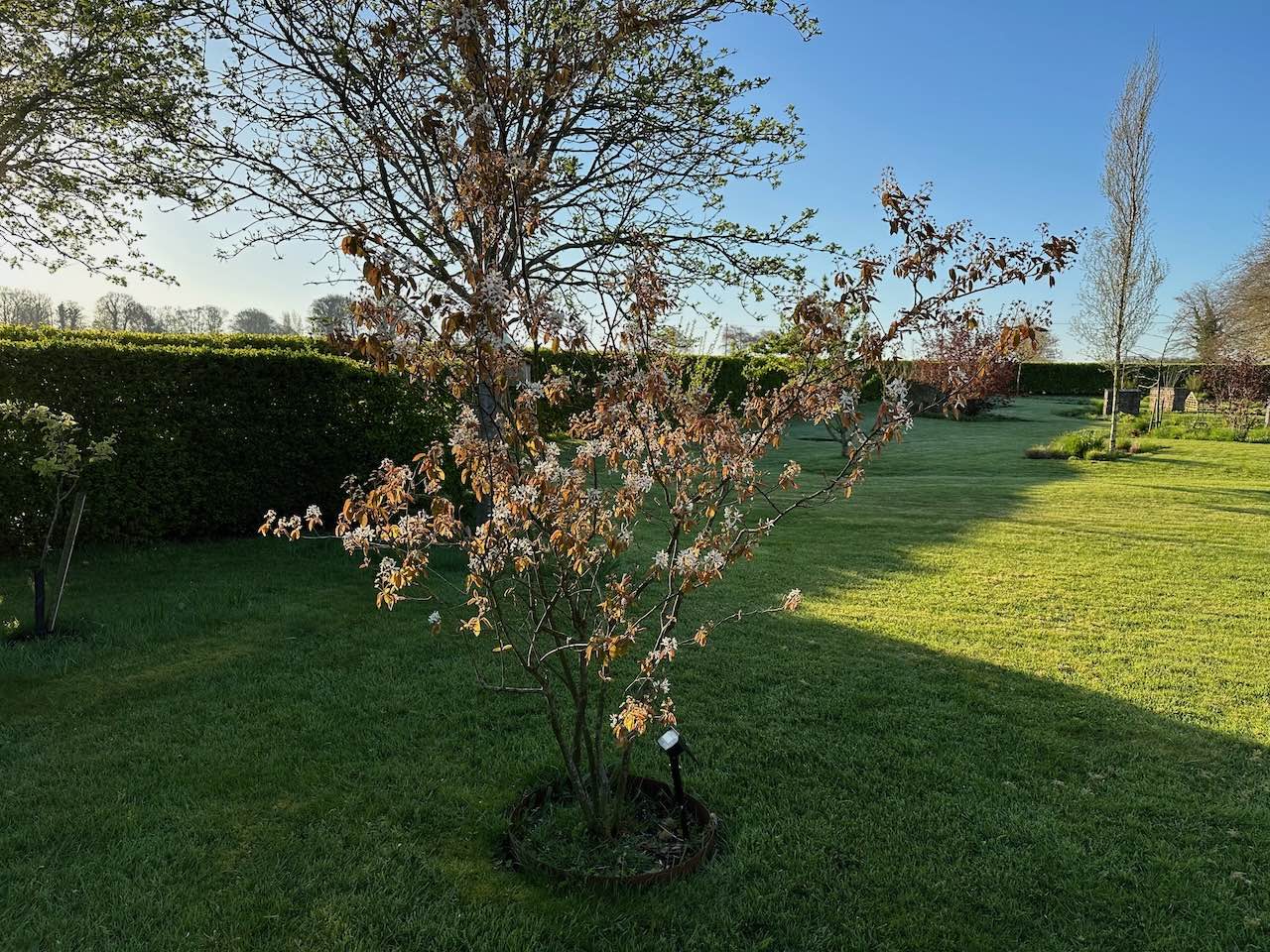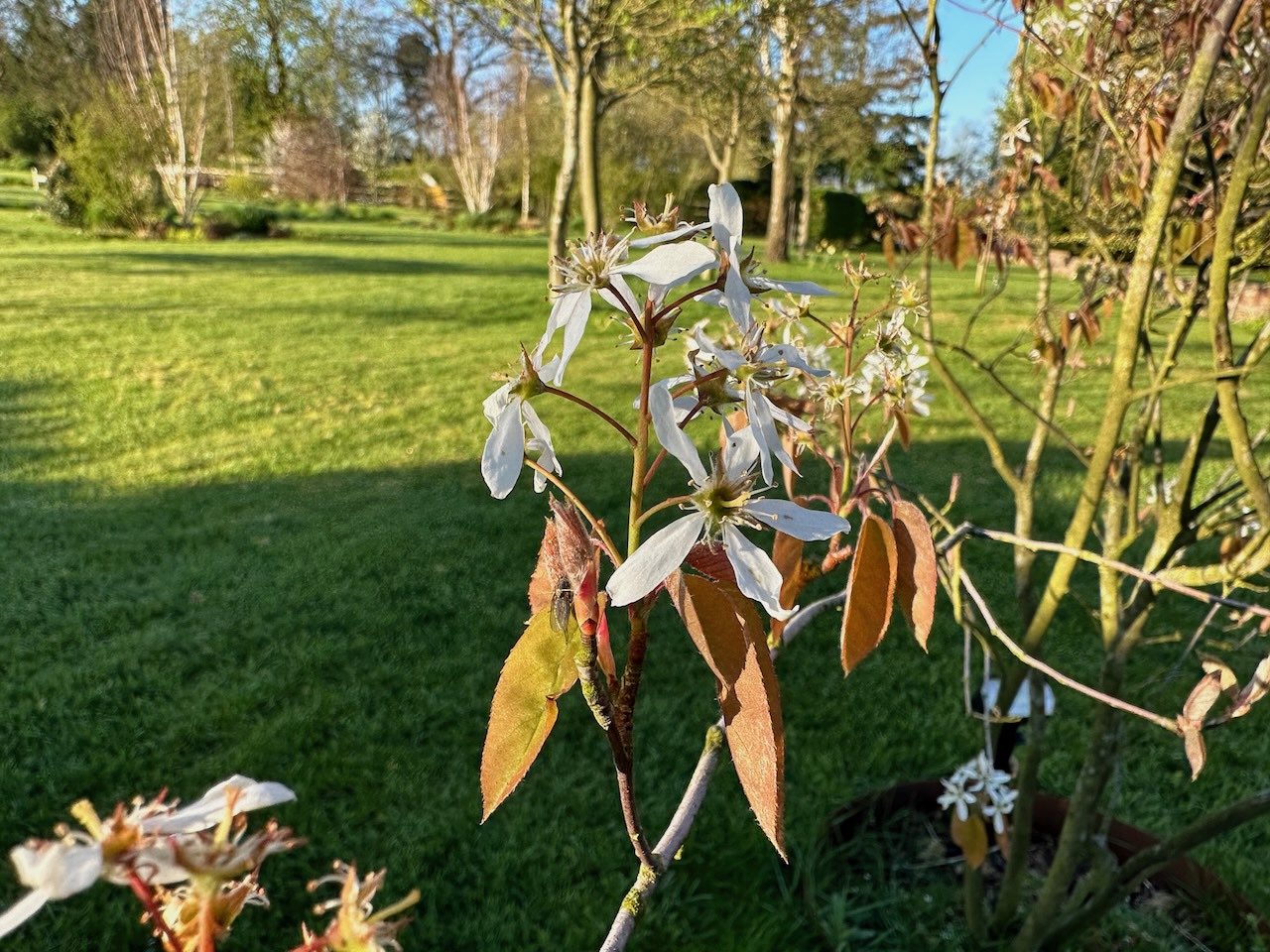Hi @gardenerett06
What a stunning Amellanchier! No wonder these shrub/trees are a secret weapon of the garden designer!
As for the cultivar its hard to say its definitely a Amellanchier lamarckii. I'd call this a multi stem shrub not a column that's the term that horticulturalists would use.

Why are Amellanchier so popular?
Amelanchier, also known as serviceberry or Juneberry, are popular for several reasons:
-
Ornamental Value: Amelanchier shrubs and trees are prized for their ornamental value. They produce delicate, white or pink flowers in the spring and colorful foliage in the fall, making them an attractive addition to any landscape.
-
Edible Berries: Another reason for their popularity is their edible berries, which have a sweet, nutty flavor and are high in antioxidants. The berries can be eaten fresh or used to make jams, jellies, pies, and other baked goods.
-
Easy to Grow: Amelanchier is easy to grow and maintain, and it is adaptable to a wide range of soil types and growing conditions. They are also relatively pest and disease-resistant, which makes them a low-maintenance choice for gardeners.
-
Wildlife Attraction: The shrubs and trees also attract wildlife such as birds and butterflies, who feed on the berries and nectar from the flowers.
- Great for small urban gardens: These shrubs are a fantastic addition to the tiniest of gardens as they are slow growing. In their multistem format they don't cast any real shade meaning you can see through them. Great to adding height to a flower bed without the bulk or shade.
When does Amellanchier flower?
Amellanchiers flower in April fro around 3 weeks before losing their blossom.

When do Amellanchier fruit?
Amellanchier fruit from June onwards - hence the name the Juneberry. These fruits are adored by birds and can be used in jams or preserves too!
Best conditions to grow amellanchier in
Amellanchier will pretty much grow in all soil types and conditions. They do require some sun though and don't do well in total shade. Here are the best conditions to grow Amelanchier:
-
Sunlight: Amelanchier prefers full sun to partial shade. They can tolerate some shade, but they produce more fruit and flowers in full sun. They also don't like full exposure ie coastal gardens.
-
Soil type: Amelanchier grows best in moist, well-drained soil that is slightly acidic. They do not tolerate poorly drained or alkaline soil. Amelanchier prefers loamy soil, but they can grow in sandy or clay soils as long as they are well-drained.
-
Watering: Amelanchier needs regular watering, especially during the growing season. They do not tolerate drought conditions and can wilt if they do not receive enough water.
-
Temperature: Amelanchier can grow in a wide range of temperatures. They are cold-hardy and can survive temperatures as low as -40°C. They also tolerate heat but may require extra watering during hot, dry periods.
-
Pruning: Amelanchier benefits from regular pruning to maintain their shape and promote fruit and flower production. Prune in late winter or early spring before new growth appears.
Hope that helps!
Lee
Hi @gardenerett06
What a stunning Amellanchier! No wonder these shrub/trees are a secret weapon of the garden designer!
As for the cultivar its hard to say its definitely a Amellanchier lamarckii. I'd call this a multi stem shrub not a column that's the term that horticulturalists would use.

Why are Amellanchier so popular?
Amelanchier, also known as serviceberry or Juneberry, are popular for several reasons:
-
Ornamental Value: Amelanchier shrubs and trees are prized for their ornamental value. They produce delicate, white or pink flowers in the spring and colorful foliage in the fall, making them an attractive addition to any landscape.
-
Edible Berries: Another reason for their popularity is their edible berries, which have a sweet, nutty flavor and are high in antioxidants. The berries can be eaten fresh or used to make jams, jellies, pies, and other baked goods.
-
Easy to Grow: Amelanchier is easy to grow and maintain, and it is adaptable to a wide range of soil types and growing conditions. They are also relatively pest and disease-resistant, which makes them a low-maintenance choice for gardeners.
-
Wildlife Attraction: The shrubs and trees also attract wildlife such as birds and butterflies, who feed on the berries and nectar from the flowers.
- Great for small urban gardens: These shrubs are a fantastic addition to the tiniest of gardens as they are slow growing. In their multistem format they don't cast any real shade meaning you can see through them. Great to adding height to a flower bed without the bulk or shade.
When does Amellanchier flower?
Amellanchiers flower in April fro around 3 weeks before losing their blossom.

When do Amellanchier fruit?
Amellanchier fruit from June onwards - hence the name the Juneberry. These fruits are adored by birds and can be used in jams or preserves too!
Best conditions to grow amellanchier in
Amellanchier will pretty much grow in all soil types and conditions. They do require some sun though and don't do well in total shade. Here are the best conditions to grow Amelanchier:
-
Sunlight: Amelanchier prefers full sun to partial shade. They can tolerate some shade, but they produce more fruit and flowers in full sun. They also don't like full exposure ie coastal gardens.
-
Soil type: Amelanchier grows best in moist, well-drained soil that is slightly acidic. They do not tolerate poorly drained or alkaline soil. Amelanchier prefers loamy soil, but they can grow in sandy or clay soils as long as they are well-drained.
-
Watering: Amelanchier needs regular watering, especially during the growing season. They do not tolerate drought conditions and can wilt if they do not receive enough water.
-
Temperature: Amelanchier can grow in a wide range of temperatures. They are cold-hardy and can survive temperatures as low as -40°C. They also tolerate heat but may require extra watering during hot, dry periods.
-
Pruning: Amelanchier benefits from regular pruning to maintain their shape and promote fruit and flower production. Prune in late winter or early spring before new growth appears.
Hope that helps!
Lee
 Lee Burkhill: Award Winning Designer & BBC 1's Garden Rescue Presenters Official Blog
Lee Burkhill: Award Winning Designer & BBC 1's Garden Rescue Presenters Official Blog



